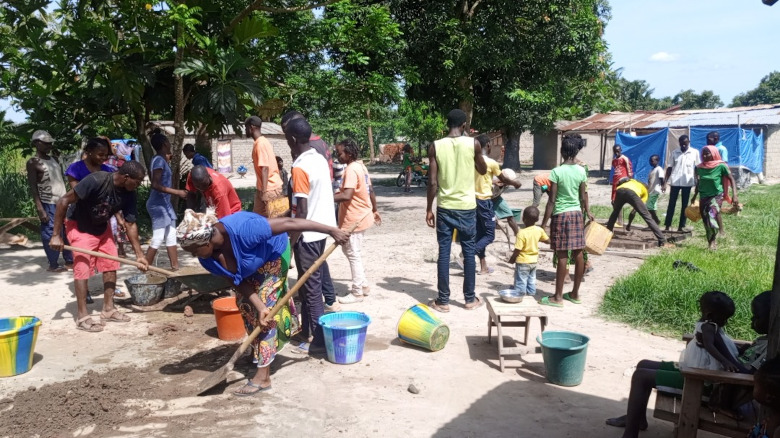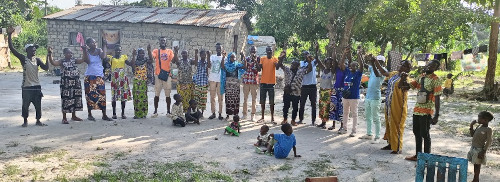Building Communities to Eradicate Extreme Poverty

By Bob Katembo, ATD Fourth World Volunteer Corps member in The Central African Republic
Building a better world that leaves no one behind
For the past several years, the Central African Republic has been hit by severe floods. These floods have ravaged impoverished regions of the country, such as Mbongossoua Island (first hit in July 2019) and the Kokoro Boeing neighbourhood in Bangui (hit in July 2022). These natural disasters have plunged these two communities even further into extreme poverty. National and international organisations have taken action and sent material aid, funding, and medical treatments…they even built a school and distributed household supplies.
Unfortunately, this aid was only short-term. Once the projects came to an end, these organisations no longer prioritised local populations, even though their circumstances had hardly changed.
The people were not discouraged; they came together to rebuild their homes and created community groups.
The aim was to rally the communities, seize their autonomy and see themselves as players in the fight against social injustice. With this initiative, these individuals would no longer just be waiting for others to take action in their place. Every community would play a significant role in working to overcome extreme poverty in order to build a better world that leaves no one behind.
The community rallies and takes action
This is the context in the creation of ‘Maboko na maboko’ (‘Stand Up and Work Hand in Hand’), which started in Kokoro Boeing following the floods on 22nd July 2022. The residents suffered much loss as the floods washed away the possessions of more than 45 families in the Kokoro Boeing community. Faced with the suffering of these families, the community rallied. It issued a call to action for creating an organisation capable of supporting those most affected by these disasters and who were, therefore, the most vulnerable.
In response, members of ‘Stand Up and Work Hand in Hand’ —men, women, and children—took action in their community to help those who had lost everything. These individuals formed work committees. They salvaged undamaged bricks, made new bricks, cleared the land, built small houses out of sheet metal to protect families, organised community works, and more. The team also recovered bridges the floods had washed away to prevent people from falling into the gutters now concealed by the torrential rainwater. They also cut tall grass to clear pathways, and so on.
At the same time, the ‘Healthcare for All Committee’ ensured access to essential healthcare. People with more challenging health issues were directed towards medical facilities. The ‘Healthcare for All Committee’ also created an initiative focussing on health education, hygiene, and sanitation. Moreover, an advocacy group led by the affected families and other individuals capable of representing the voice and lived experience of those in extreme poverty rallied community players to help those most crushed by poverty. Finally, a cultural actions group facilitated a range of initiatives enabling children to rekindle their joie de vivre and to alleviate the stress induced by their experiences of the floods.
Water access in Kokoro Boeing
Against this backdrop, families in Kokoro Boeing rallied again to organise a solidarity project and equip themselves with a clean water well.
In Kokoro Boeing, access to clean water is challenging. Almost 600 people use one single well. During the rainy season, the well water is dirty and turbid from rubbish falling into it. Despite the risks (waterborne diseases, typhoid, and staphylococci), the community cannot get water anywhere nearby and must depend on the well for their water.
The water supply from SODECA (the Central African Water Distribution Company) was cut off by the floods, and the supply networks have not yet been repaired. Access to drinking water is now located in a neighbourhood 4 to 5 kilometres away. The residents have to set off at dawn to use this water supply. Therefore, the families living in extreme poverty have no choice but to use the community well.
Construction of a Water Well in Kokoro Boeing
Over the course of four meetings, men and women from the community created a solidarity project in partnership with the ‘Stand Up and Work Hand in Hand’ project. During the planning stage, these individuals shared what they wanted to achieve for their community and decided to prioritise access to clean water for those struggling to obtain it.
This solidarity project lasted longer than a month. It started with constructing a slab to cover the entire well. Then, a group dug down several metres and placed the slab. The finishing touches were made after placing bricks around the circumference of the well to protect the water inside. More than 75 adults and children took part in this project. New people arrived every day to ‘lend a helping hand’. Currently, they are increasingly involved in community activities.
- The work was organised with a spirit of collegiality, mutual aid, and co-responsibility. Some people went to look for sand and pebbles, while others cut the reinforcing bars, collected water, or covered the slab with mortars; others kneaded the mortar. Donations made by residents, each according to their willingness and capacity to give financially, were collected. The participants learned to carry out tasks by using each other’s knowledge. They completed the group work in line with the motto, ‘work hand in hand’.
Everything came from the community: the workforce, the financial contributions used to pay for the materials, the 30 concrete blocks brought by one family, boards brought by another, tools given by yet another…A makeshift kitchen was set up for making coffee and meals. The community involvement was remarkable.
This work has brought about cohesion, solidarity, and fraternity among the families in the community. The residents, predominantly Christians, had no prior connection with a small minority group of Muslims from the northern part of the neighbourhood, mainly because of the considerable distance that separated them. Thanks to the project, these individuals met each other and worked together from beginning to end. They are now united and regularly take part in community activities.
What the participants had to say

The following quotes recount the experiences of those who participated in the initiatives:
- “Everything went very well. This project symbolises social cohesion in our area. Christians and Muslims met, gathered, and worked together”.
- “The Ilondo group came to bring us together, first during the preparatory meetings, then during the well construction project. I am so happy because people came from all around to gather together for this project. I thought this work was only for men, but women also took part in building the well. It’s a sign that there is strong cohesion in the community. I will continue to participate in activities organised by this group”.
- “Young people have really taken action; it’s a good thing. Their courage has moved people like me—it’s what made me get involved in this project. The ‘Stand up and Work Hand in Hand’ group is an excellent initiative which has brought us together. The initial reason behind this group was water; as they say, water is life. This unity serves as a symbol of peace”.
- “I am part of the ‘Stand up and Work Hand in Hand’ group. This project enabled our community to build itself a well. We come together to work against extreme poverty and to advance our country. We young people will continue doing so in order to support those in our community who are the most vulnerable. This project is about lending a helping hand and extending it to others. It has enabled us to help each other, the older adults in our community, and our mothers. Our work in this group involved building a well and other projects, such as rebuilding the houses flattened during the floods. We are working for those who do not have the strength or the means and those living in extreme poverty”.
- “When I gave birth, there was no clean water for me to use when taking care of my baby. We were forced to use water from the well, and my baby caught scabies and staphylococcus. Even we adults suffered later on from illnesses, and we didn’t have the means to get to hospital for the proper treatments. Today, I am thrilled to participate in this project with my child, serving as an example to ensure we have the courage to build our well together, hand in hand”.

